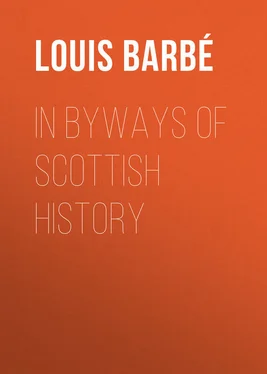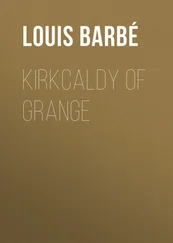Louis Barbé - In Byways of Scottish History
Здесь есть возможность читать онлайн «Louis Barbé - In Byways of Scottish History» — ознакомительный отрывок электронной книги совершенно бесплатно, а после прочтения отрывка купить полную версию. В некоторых случаях можно слушать аудио, скачать через торрент в формате fb2 и присутствует краткое содержание. Жанр: foreign_antique, foreign_prose, на английском языке. Описание произведения, (предисловие) а так же отзывы посетителей доступны на портале библиотеки ЛибКат.
- Название:In Byways of Scottish History
- Автор:
- Жанр:
- Год:неизвестен
- ISBN:нет данных
- Рейтинг книги:4 / 5. Голосов: 1
-
Избранное:Добавить в избранное
- Отзывы:
-
Ваша оценка:
- 80
- 1
- 2
- 3
- 4
- 5
In Byways of Scottish History: краткое содержание, описание и аннотация
Предлагаем к чтению аннотацию, описание, краткое содержание или предисловие (зависит от того, что написал сам автор книги «In Byways of Scottish History»). Если вы не нашли необходимую информацию о книге — напишите в комментариях, мы постараемся отыскать её.
In Byways of Scottish History — читать онлайн ознакомительный отрывок
Ниже представлен текст книги, разбитый по страницам. Система сохранения места последней прочитанной страницы, позволяет с удобством читать онлайн бесплатно книгу «In Byways of Scottish History», без необходимости каждый раз заново искать на чём Вы остановились. Поставьте закладку, и сможете в любой момент перейти на страницу, на которой закончили чтение.
Интервал:
Закладка:
The work at which such grievous offence had been taken was entitled Maister Randolphe's Fantasie , and the informant who had given Mary notice of its publication had also assured her that it was in reality what it purported to be, the production of the agent who, till within a short time previously, had represented England at the Scottish Court. She accepted the charge without question and without doubt. In her mind Thomas Randolph was associated with all the intrigues which had culminated in the open defection and organized opposition of the most powerful of her nobles, and she felt conscious of having treated him with a harshness calculated to add an ardent desire for revenge to the malevolent intentions by which she believed him to be actuated. During the last six months of his residence in Edinburgh he had been subjected to a series of petty vexations, of personal attacks and of open accusations, which even his avowed partisanship could not justify, and which were not less discreditable to the instigators of them than insulting to the sovereign whom he represented. On the formation of the league to which Mary's marriage with Darnley had given rise he had been threatened with punishment "for practising with the Queen's rebels". 117Mary herself had shown her displeasure in so marked a manner that Randolph had sent to England a formal complaint of the difficulties thrown into his way by her refusal to give him access to her presence, even on official business. 118When at last she did grant him an audience, it was not for purposes of political negotiation, but solely to upbraid him "for his many evil offices" towards her. 119The dread of immediate imprisonment, 120and the personal violence to which he was actually subjected, 121had rendered his position so intolerable that he petitioned for permission to retire to Berwick. 122His request was denied him; but the consequences of the refusal soon showed how ill-advised had been the action of those who had insisted upon his continuance in functions for which he now lacked the essential conditions of favour and security. In the beginning of the following year he was summoned before the Queen in Council, and publicly accused of abetting the Earl of Murray in his treasonable designs, and supplying him with funds to carry them out. 123In spite of his direct and explicit denial of a charge which was in reality without foundation, he was ignominiously ordered to leave the country. 124Anxious as he had been to be relieved from duties which had become as dangerous as they were difficult, Randolph nevertheless refused to obey. He appealed from Mary and her Lords to Elizabeth, to the sovereign to whom he owed his allegiance, and was answerable for his conduct, by whose favour he had been appointed to a position of confidence and honour, and at whose command alone he would consent to surrender his trust. On hearing the slight which had been put upon her accredited representative, the Queen of England took up his cause with characteristic promptitude and energy. She at once dispatched a letter to the Queen of Scots complaining "of her strange and uncourteous treatment of Mr. Randolph", 125and informing her that his departure from Edinburgh would be the signal for the dismissal of the Scottish agent from the English Court. In spite of Elizabeth's remonstrances, and in the face of a threat which was so far from being idly meant that it was peremptorily carried out less than a fortnight later, 126Randolph's expulsion was insisted upon. After having twice again received orders from the Lords, 127he at length yielded to necessity and retired across the Border to Berwick.
That Randolph, smarting under such treatment, should have made use of his enforced leisure and of the knowledge which he had had special opportunities for acquiring to write a book by which he hoped to injure her cause and tarnish her reputation, doubtless seemed to Mary to be so natural that she deemed it unnecessary to institute further enquiries into the truth of the charge brought against him. His guilt was assumed as soon as the accusation was made, and, by a singular coincidence, if, indeed, it was not of set purpose, the same Minister whose dismissal had followed his own disgrace was sent back to Elizabeth to demand his punishment.
Конец ознакомительного фрагмента.
Текст предоставлен ООО «ЛитРес».
Прочитайте эту книгу целиком, купив полную легальную версию на ЛитРес.
Безопасно оплатить книгу можно банковской картой Visa, MasterCard, Maestro, со счета мобильного телефона, с платежного терминала, в салоне МТС или Связной, через PayPal, WebMoney, Яндекс.Деньги, QIWI Кошелек, бонусными картами или другим удобным Вам способом.
1
For an account of this poem, Maister Randolphe's Fantasie , see pages 91-98.
2
As bearing on the subject of Mary's personal appearance and the fidelity of her portraits, the following passages from an article contributed to the Glasgow Herald , as a review of Mr. J. J. Foster's work, Concerning the True Portraiture of Mary Queen of Scots , may here be reproduced: "Mr. Foster points out 'in some cases a slight but perceptible squint'. We have noticed this in one or two instances only, and in portraits which, though they may be authentic, are technically inferior; and we are consequently more inclined to attribute the defect to the artist than to nature. The majority of the most trustworthy portraits agree in making the upper eyelids thick, with an uninterrupted curve, in setting the arched, well-marked eyebrows wide apart, and in giving an exceptionally broad space between the eyes and the ears. The oval face, the high cheek-bones, the round, well-proportioned and capacious forehead, the long but shapely Greek nose, are features with regard to which there is practical unanimity. Even if Sir George Scharf had not pointed it out, it would hardly be possible to overlook the peculiarity of the compressed lips. They are not thin, however, though, on the other hand, they are very far from possessing that fulness which physiognomists look upon as an indication of sensuality. Another feature, so often reproduced as to be almost characteristic and distinctive, is the strongly-marked V depression in the middle of the upper lip. The cheek is full in its lower part, but not unduly so. The chin is well-developed, but is neither cloven nor dimpled… Prince Labanoff declared that, with the exception of one portrait – and that of dubious authenticity – none renders even youth or average beauty. Quite recently Major Martin Hume wrote of Mary that 'a contemplation of her known authentic portraits, even those taken in the best years of her youth and happiness, does not carry conviction that her physical beauty alone can have been the cause of the extraordinary influence she exercised over the men who came within the sphere of her attraction'. And now we have Mr. Foster admitting that 'scarcely any of the so-called portraits of Mary Stuart bear out the reputation of her beauty'; and that 'all her pictures entirely lack that indefinable charm which captivated everyone brought in contact with her'. He seems to attribute this, in some measure, at least, to the imperfections of the artists of the time. He might perhaps have added, to the unfavourable circumstances under which they worked. For, as M. Dimier tells us, 'the oil-painting was never attempted from life. The artist brought away from his model nothing but the crayon and some written notes concerning the complexion, colour of hair, and of the eyes; he handled the colours only in his studio, and finished the work at his leisure'. We know, too, of Mary Stuart, in particular, that she ordered portraits of herself to be painted in France, fourteen years after leaving the country."
Читать дальшеИнтервал:
Закладка:
Похожие книги на «In Byways of Scottish History»
Представляем Вашему вниманию похожие книги на «In Byways of Scottish History» списком для выбора. Мы отобрали схожую по названию и смыслу литературу в надежде предоставить читателям больше вариантов отыскать новые, интересные, ещё непрочитанные произведения.
Обсуждение, отзывы о книге «In Byways of Scottish History» и просто собственные мнения читателей. Оставьте ваши комментарии, напишите, что Вы думаете о произведении, его смысле или главных героях. Укажите что конкретно понравилось, а что нет, и почему Вы так считаете.












